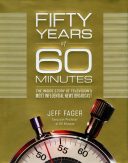
With his new book, Fifty Years of 60 Minutes: The Inside Story of Television’s Most Influential News Broadcast (Simon & Schuster), Jeff Fager ’77 regales readers with behind-the-scenes reports. He writes about embarrassing set disasters as well as real-world tragedies. He shares personal experiences, including arm wrestling Vladimir Putin and, on the more serious side, a mistake that Fager calls “the worst on [his] watch.” Like any well-told story, Fager’s anecdotes focus on the human drama and the people involved — including Mike Wallace, Morley Safer, Ed Bradley, and, of course, Colgate’s most beloved curmudgeon, Andy Rooney ’42, P’74, GP’05.
(Top photo: Fager [right] with Morley Safer. Photo credit: CBS News/60 Minutes)
In its first year, 1968, the broadcast came in 75th out of the 81 programs airing that season. It took six years and several moves to different time slots until 60 Minutes landed in its permanent spot on the schedule, Sundays at 7 p.m. Only then did it start to get traction.
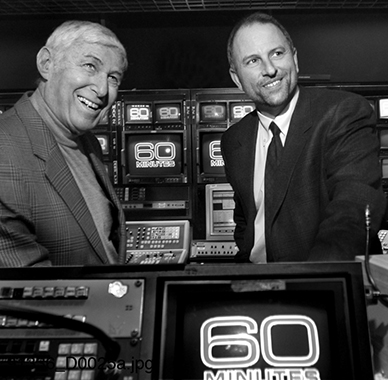
Don Hewitt (left) handed over the reins to Fager in 2004. Photo credit: John Filo/CBS
By the time my generation came along, 20 years later, it had become a hit… That prime decade encapsulates in many ways the reasons 60 Minutes did achieve enduring success, both through its original genius and its ability to constantly reinvent itself.
Like a lot of young producers who first arrive for work at 60 Minutes, I wasn’t quite sure what to expect. But Don Hewitt settled that within a few hours on the job. “We don’t have meetings, and there are no memos to the staff,” he told me. “Just bring us good stories and everything will be all right.”
There was a journalistic spirit at 60 Minutes that I felt from that first day on the job in 1989, during the twenty-first season. It was a sense that the story came first, and that the rituals and obsessions of most every other television news organization, including our own CBS News organization, did not matter so much.
I was hired as a producer to work with Steve Kroft, the first young male correspondent since Ed Bradley had joined in 1981. There was a lot of pressure on him and on me. Could we do the kind of work expected of us? I remember Mike Wallace taunting me in the hall: “We’ll see if you can handle it soon enough; see if you’re good enough to be here.” There was a twinkle in his eye, but I couldn’t tell if he was kidding or not, which was a fundamental part of his appeal. He was a rascal — a very likeable rascal — with a big heart and a manic personality.
Being around Don and Mike and Morley Safer and Ed Bradley was a real thrill and an honor, but they were nervous about us newcomers. Nobody wanted the “kids” to screw up what they had worked so hard to build. Still, we were pretty much left to fend for ourselves.
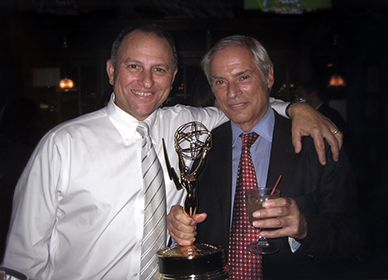
Fager and Bob Simon celebrating an Emmy win. Photo credit: Harold Gold
It was an adult place to work, with little supervision and high expectations, a refreshing place to be for Steve and me. We had grown up in the hard news part of CBS News, covering conflicts, summits, plagues, and floods out of the London bureau. Steve had already earned a reputation as one of the finest storytelling correspondents in an organization that included the very best. He was confident he could do the work well.
Still, we both had to earn the right to be there. I found that out early in a conversation with Don’s number two, Phil Scheffler, the executive editor of the broadcast. Phil was crucial, always trying to make sure the journalism was solid and accurate. We liked to joke that his sour and gruff exterior camouflaged his prickly interior.
A month or so after starting on the job, I took a deep breath, entered his office, and said, “Phil, I have worked at CBS News since 1982. I have covered the world and every kind of story, and I always thought that coming here would be a promotion. So, I’ve been looking for a raise.”
He looked up with a scowl and said, “Then why don’t you start looking for another job.” He looked back down at his papers, and I slowly, one step at a time, backed out of his office.
At the time they were handing out new computer terminals to replace the old typewriters. I didn’t get one of those, either.
The first story Steve and I did was about the chief of orthopedics at San Francisco General Hospital, Dr. Lorraine Day, who was angry that not enough was being done, in her opinion, to protect physicians against the occupational risk of infection with HIV. Producing the story was a first lesson in life at 60 Minutes.
In 1989 the AIDS epidemic was raging, and San Francisco, with its huge gay population, was at the epicenter. Not since polio had there been such a fear of a virus, and Dr. Day wanted doctors to understand their risk of infection. The story promised to be provocative and controversial, and Dr. Day did not disappoint. We had heard that she wore what amounted to a space suit in the operating room to protect her from the potentially infected blood of her patients. She agreed to let us film her in the suit.
Lorraine Day was a perfect 60 Minutes subject because she wasn’t at all shy about her position. She was outspoken and passionate, though we wondered if there wasn’t some homophobia behind her complaints. Her position did not include much, if any, compassion for the predominantly gay population suffering horribly from the disease, but she was unequivocal: treating AIDS patients could be life threatening. She backed her opinions up with a statistic that accidental injury from a contaminated needle was estimated at one in 200 by the U.S. Centers for Disease Control.
“If you came to work every day and flipped the light switch on in your office, and only one out of two hundred times you would get electrocuted, would you consider that low risk?” she asked on camera.
Dr. Day had created a stir at the hospital, and she had significant opposition, articulated well in our story by Dr. John Luce: “I think that having fears about HIV infection and AIDS is very appropriate and I think any physician that doesn’t have fears about getting infected is crazy. At the same time I think carrying the fear to the point that Dr. Day does, and to try to instill [fear], and I believe she has instilled fear in other people, is wrong. I think that Dr. Day is an alarmist.”
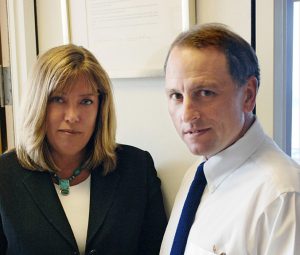
Patti Hassler, who was Fager’s deputy at 60 Minutes II, eventually moved into that role at 60 Minutes. Photo credit: John Filo/CBS
We reported and filmed the story during our first summer and got ready to show it to Don in August so that it could run in the new television season starting in mid-September. By the time we sat down to interview Dr. Day, she had promised to reveal on 60 Minutes that she had decided to quit over the issue. Now we had some news to go with our first story.
After about six weeks of shooting and writing and rewriting and reorganizing, we thought we were ready to show the story to Don. Screenings at 60 Minutes are infamous. In CBS News mythology, they’re usually associated with strong language and shouting matches. A team made up of a producer, a correspondent, and a videotape editor had worked for months to get the story into good shape, but it was well known that Don could hate the result. This was a frightening possibility even for the veterans; for a newcomer, the experience was like being a rookie up at bat for the first time in Yankee Stadium. And there was an added twist at our first screening: Mike Wallace decided to attend to see if the new guys were any good. We knew that if the screening did not go well, Mike would make sure that everybody on the Eastern Seaboard knew about it.
To our relief, we got a round of applause when the lights came on. And Don made the story better by making it more about Dr. Day. He had us drop a scientist, calling him “Marvin the expert.” You don’t need Marvin the expert, he argued, when you know as much about this story as he does.
An important lesson learned eventually by most everybody who works at 60 Minutes is to choose your stories well, because you will be living with them for a long time, and it can be very painful if they don’t work out well. Soon after the fall of the Berlin Wall, the Soviet Union’s future was the biggest story — and Steve and I wanted to get in on it. We looked at the Eastern Bloc states, which were winning their freedom one by one.
I started working on a story about Poland attempting to start up a free market system, and came upon the Harvard University economist Jeffrey Sachs, who was working to help the country pull it off.
We sent the story idea to Don and Phil Scheffler in the form of a blue sheet: the traditional term for a story idea because the paper on which a producer used to pitch a story was blue. Don told me within a few days that he didn’t like the idea, but that we could do it if we thought he might be wrong. Don always wanted us to work on stories we wanted to work on.
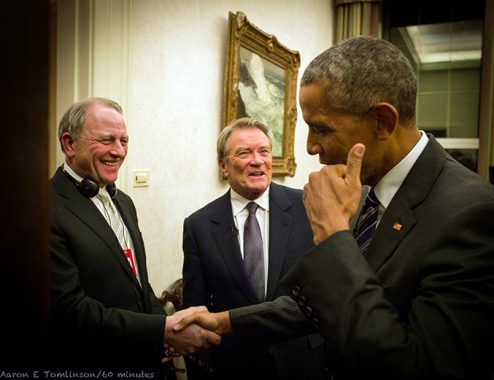
President Barack Obama joked with Fager and Steve Kroft after his January 2017 exit interview that they would stop taking his calls once he left the White House. Photo credit: Aaron E. Tomlinson
He was the boss, but even if he didn’t like your idea, he would give you the green light if you were passionate about it.
We decided to go ahead, against Don’s instincts, and shot the story in Poland. By midwinter, we were ready to show it to him. The 60 Minutes room is a comfortable place, with theater seating and a big monitor in the front of the room. In those days, the correspondent sat out in the seats with senior producer Merri Lieberthal, while Don and Phil sat behind a small desk. The producer sat in an elevated area toward the room, next to the senior editor, Esther Kartiganer, who timed a clock. The lights dimmed, the tape rolled, and everybody watched. In this setting, a story always looks different, even to those who have been editing it for weeks. Sure enough, as I watched it with the group for the first time, our story seemed … kind of boring.
When the lights came on, Don swiveled his chair around in my direction and looked up at me sitting on the elevated platform. That’s when he asked me, “Where do you want it, kid? Right between the eyes?”
Don hated the story, and at that point, so did I. So did Steve. A bad screening was one thing, but “right between the eyes” seemed worse. I remember going home to my wife and kids in a bit of a daze. Then the phone rang. It was Don. He said he had an idea for how to fix the story and asked that we meet him the next day in the edit room. The story became much more about the brilliant young economist Jeff Sachs — called in to save the new independent Polish government — and much less about turning an Eastern European economy toward capitalism. Within a week, we were back in the screening room. Don gave us all the credit for turning around the story, even though the suggested improvements came from him.
Several years later, when I was offered the job of executive producer of the CBS Evening News, I asked Don what he thought I should do. He told me to take it because there is no better feeling than helping someone make his or her story better. I remember thinking back on that damn Poland story and knowing he was right.
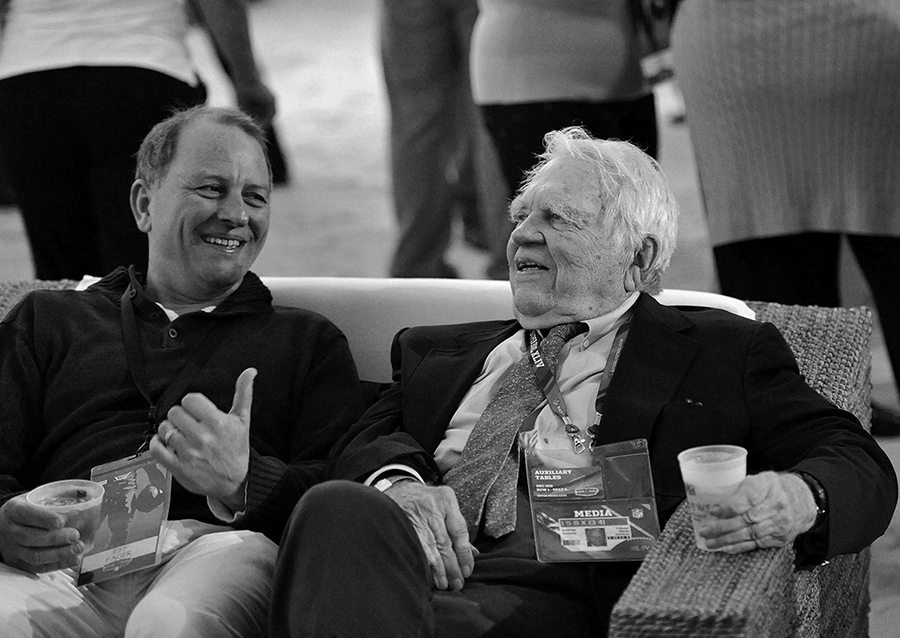
Jeff Fager and Andy Rooney at the 2010 Super Bowl. Photo Credit: John P. Filo/CBS ©2010 CBS BROADCASTING INC. ALL RIGHTS RESERVED.
Remembering Andy Rooney ’42, P’74, GP’05
By the third decade of 60 Minutes, Andy had become a fixture at the end of the broadcast. He succeeded in that spot because he was direct, original, and provocative. People always asked me, “What’s he like?” The short answer is “Just like what you see on TV: not a phony bone in his body.” I remember being with him years later at a Super Bowl cocktail party. He was sipping his usual Maker’s Mark on the rocks when a friend of mine, Bruce Taub, approached. I said, “Andy, you should meet this man. He’s the CFO of CBS. He’s the one who signs your paycheck every week. He’s responsible for all of that money at CBS.”
Andy, without missing a beat, said, “Well … nobody’s perfect,” took a sip of his bourbon, and walked away.
Andy was thoughtful, quick, smart, and funny. His genius was as an absurdist, commenting on the things in daily life that make no sense at all.
Most of his comments were benign or simply amusing — about silly trends or consumers getting ripped off.
This was a typical Andy piece from that period:
“Here’s a regular box of fake strawberry Jell-O that costs $1.05. And here’s a smaller box of Jell-O without sugar that costs $1.19. Now; you could say that whatever they put in instead of sugar costs more than the sugar in Jell-O, but what about these cans of Hunt’s tomato sauce? Both the same size, but this one costs ten cents more than this one, because they didn’t put any salt in this one.”
The war in Iraq brought out the best in the curmudgeonly — bordering on belligerent — side of Andy Rooney. Our resident veteran reporter of World War II was not happy about “shock and awe,” the phrase the Bush administration was using to describe the Baghdad bombing campaign. Not many people on television, let alone prime-time television going out to 14 million people, had the stature to say something like this: “Experts talk about precision bombing, but on the ground where bombs hit, it’s not precise. People are killed, history destroyed. We didn’t shock them and we didn’t awe them in Baghdad. The phrase makes us look like foolish braggarts. The president should fire whoever wrote that line for him.”
I loved working with Andy. In all his years with 60 Minutes, he had never moved his office from the CBS Broadcast Center, which had been CBS News headquarters since the early 1960s, to our offices across the street on the ninth floor of the Ford building, where 60 Minutes had been since the mid ’70s. He liked being separate because it made him feel independent.
He would cross the street once a week with his team — cameraman-tape editor Keith Kulin and associate producer Susie Bieber — to show me his weekly commentary. I rarely suggested changes, though when I did he was always responsive. Andy was a real reporter who wanted to show his stories to an editor with fresh eyes. When the screening was over, he would duck into Morley Safer’s office to catch up on some gossip before heading back across the street.
— From Fifty Years of 60 Minutes by Jeff Fager. Copyright @ 2017 by CBS Worldwide Inc. Reprinted by permission of Simon & Schuster, Inc.

